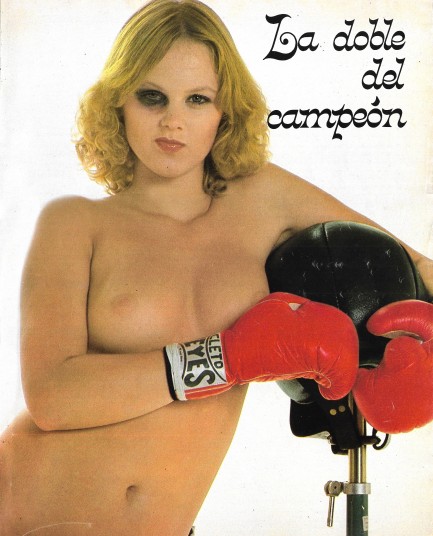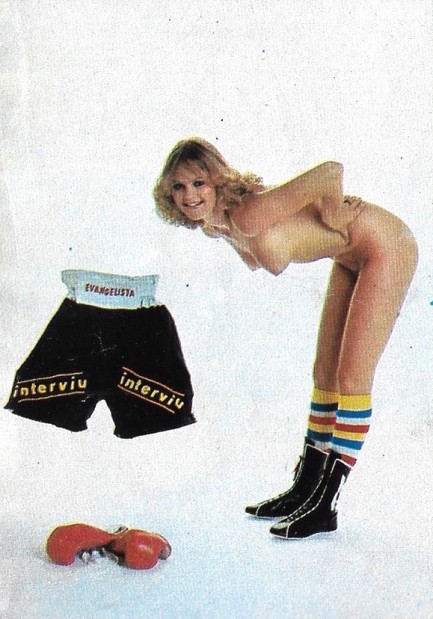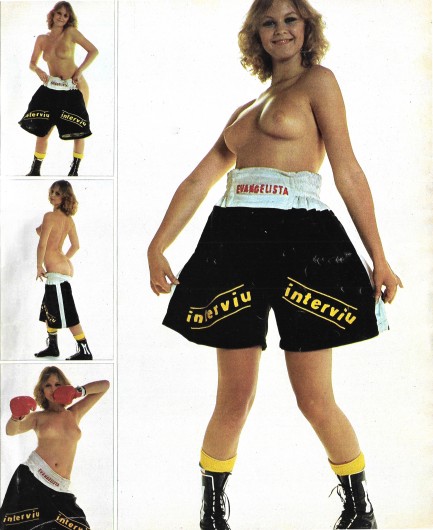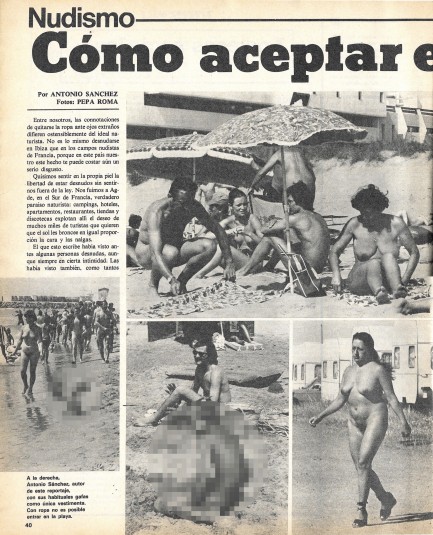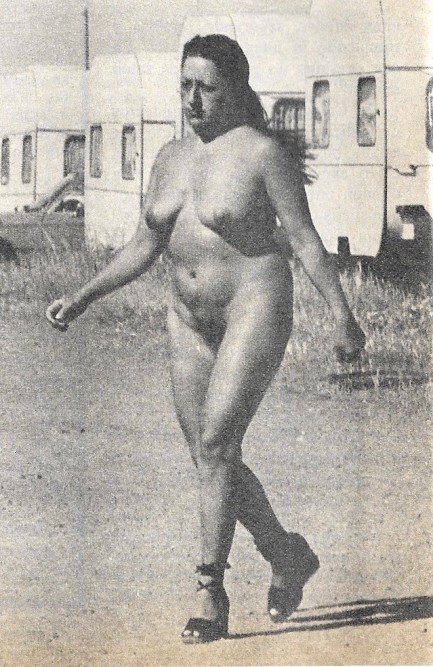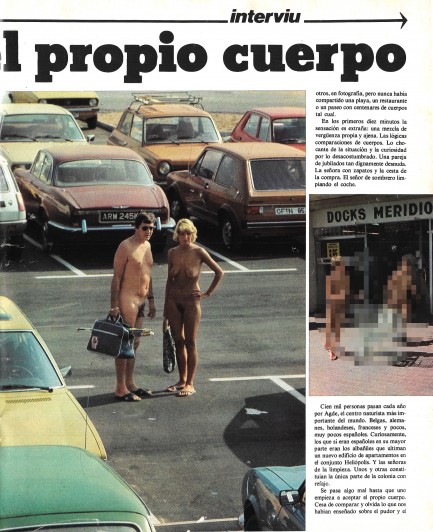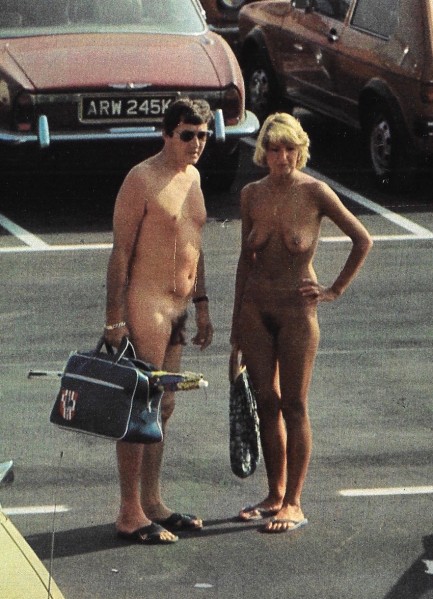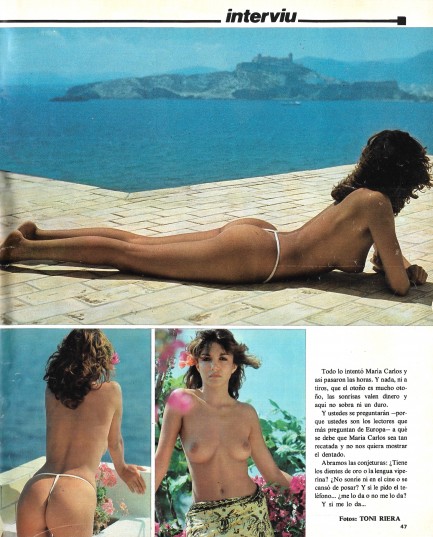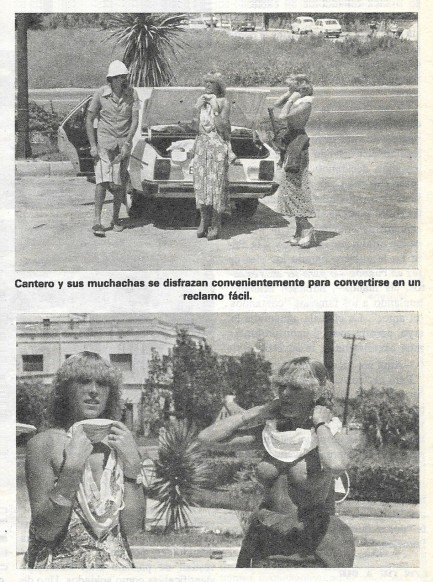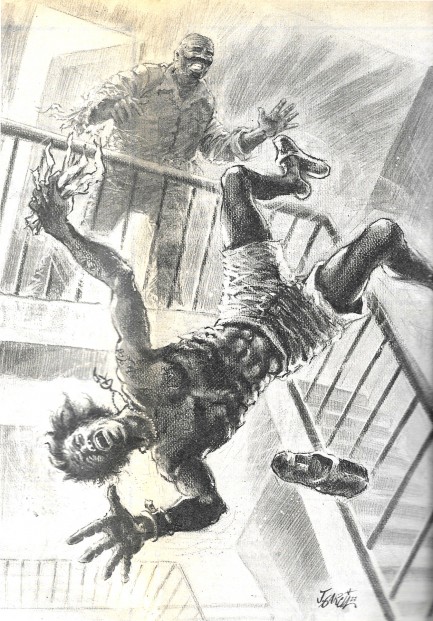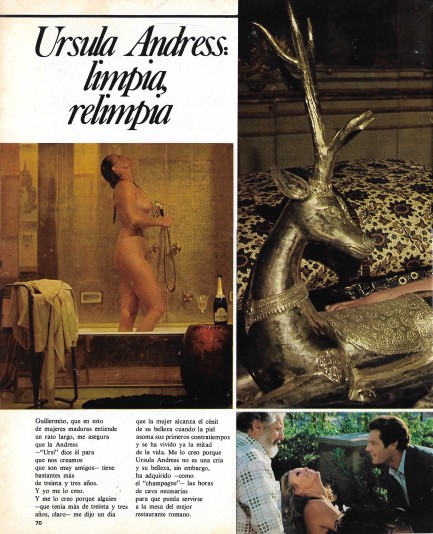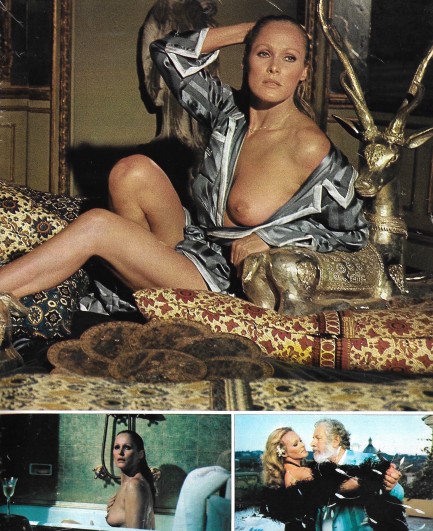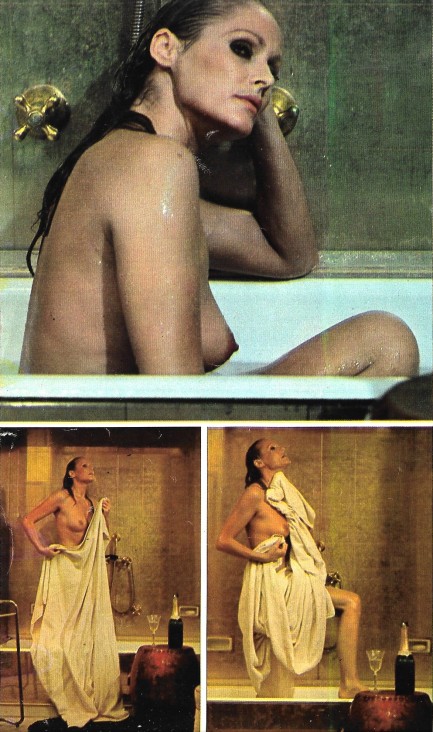 Clean-up needed in the peepshow aisle. Repeat. Clean-up in the peepshow. 
This guy should probably have been in combat gear slogging through stifling heat on a Pacific island, but instead, today in 1942, he was getting a cheap thrill by checking out a reel called “Back to Nature.” Maybe he had bone spurs that kept him out of uniform. In any case, he's using a coin operated mutoscope, which had been patented in 1894 and quickly became popular throughout the U.S. They were often stationed in arcades and carnival peep shows, and usually contained tittilating content—in this case a nudism vignette—though they sometimes showed travel, nature, or comedy. We weren't sure whether the racier displays featured any actual nudity, but we quickly found out because the internet knows all. Some enterprising folks have uploaded various mutoscope reels, which you can see at a YouTube playlist here.
 If you let yourself be free what amazing things you'll see. 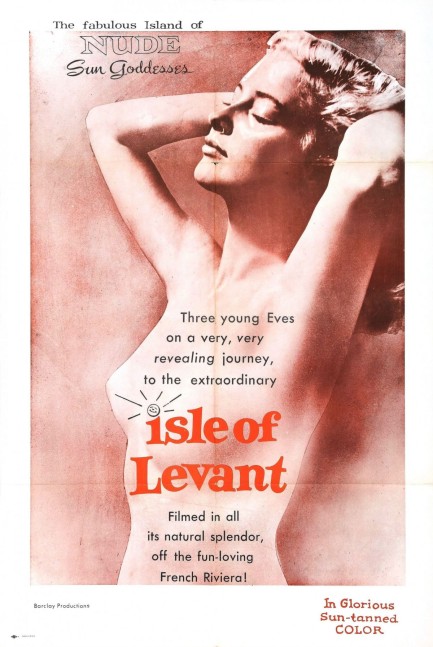
Nudism or naturism is yet another staple of mid-century publishing. Numerous magazines were devoted to the practice, and many novels we've read, such as Marriage Can Wait, Murder Doll, High Red for Dead, and of course, the immortal Nudist Camp, feature nudism. It's also featured in some pretty fun movies, such as 1962's Blaze Starr Goes Nudist. So when we saw this poster for Isle of Levant, one of the seminal nudism movies of the 1950s, we decided to have a look. The film was made by Swiss director Werner Kunz and originally titled Lockender Süden. In its English language version it's professorially narrated by E.V.H. Emmett. The story told is about a trio of young Danish women and their dog who take a road trip through Germany, Switzerland, and France to arrive in the Côte d'Azur and get naked on Île de Levant. It's largely a travelogue, but it's also pretty interesting from purely historical and architectural perspectives. Aided by the familiar visual of a crawling line on a map, you see the sights as the trio passes through Hamburg, the Rhine Valley, Rottenberg, Zurich, the Rhône Valley, Avignon, Cannes, Nice, Saint-Tropez, and Le Lavandou, all before the era of modern mass tourism, in a classic Fiat 600 Multipla, with its rear engine and backward front doors.
As for the nudism, Kunz makes you wait for it. About forty minutes into the sixty-eight minute exercise the girls hit the island and their clothes hit the sand. At first, many people wear g-strings, but later there's nothing. As is typical for such films, the nudists are the best-looking examples from far and wide. Activities range from volleyball to hiking to sketching to snorkeling to boating, but as this is a lifestyle film, there's no sex nor hint of it. Because nudism isn't—and wasn't then—considered sexual by its practitioners, there are a few brief shots of naked children. We live in a country where naked children on beaches are not a strange sight and we pay them little mind, but in terms of filmed reality, this is where things acquire a double layer. Selling films of naked children changes everything. Though these nudism flicks were ostensibly educational, and the nudists themselves agreed to appear as a way demonstrating the advantages of their lifestyle, a large percentage of the actual consumers of the movies—surely—got off on them. And for a small subset, thence, nude children.
In a sense, the nudists of the era, despite the purity of their beliefs, were exploited by filmmakers, who knew—again, surely—that the money that flowed in was from seekers of knowledge about nudism and seekers of boners over naked women and men. As for pedophiles, though they were a segment of society that were basically never thought about by the populace at large back then, we suspect the filmmakers were aware of them. In any case, nobody is unaware today, which is why those shots now stand out in neon. But if you wear your shiny happy 1950s glasses, Isle of Levant is worth a gander. It's a historical curiosity, and one that made us nostalgic for an era in which we never lived. Because they were uncredited, we'll never know who the trio of roadtrippers were, but we had an overwhelming sense of time passed and innocence lost watching them. And we thought: To have made that journey with them from Denmark through the Rhine Valley to the idyllic Côte d'Azur would have been so very fun.
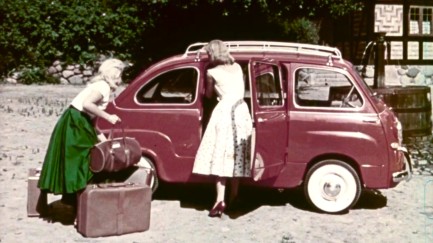 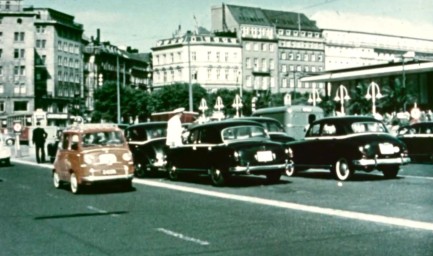   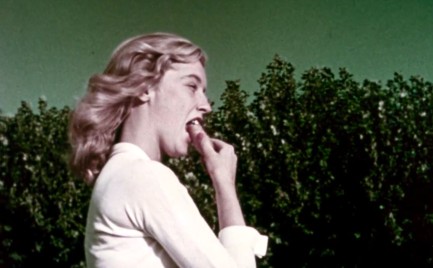  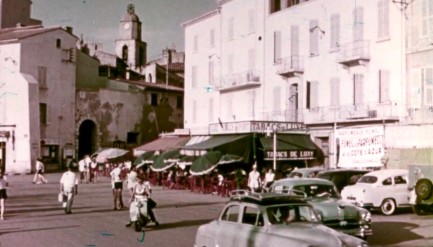 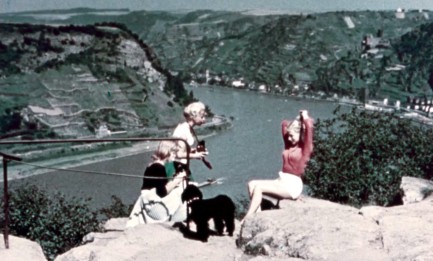 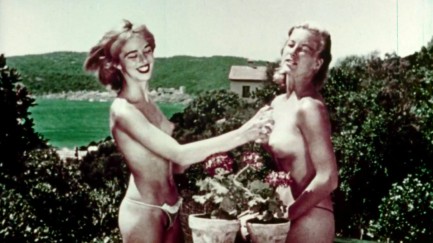 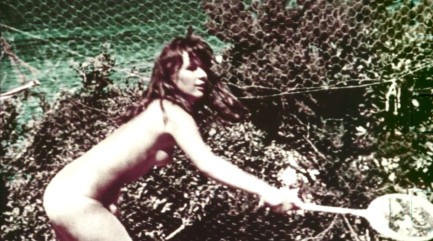 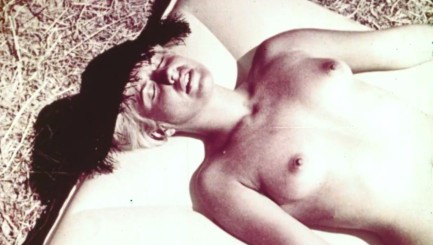 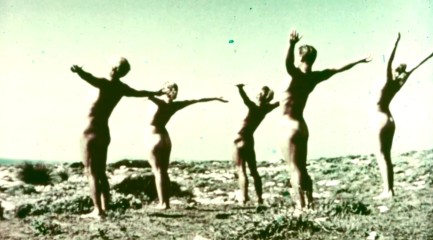 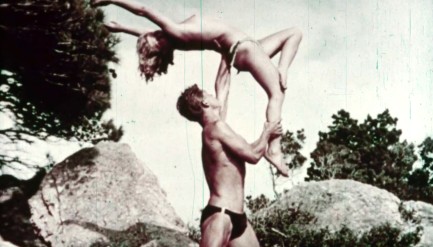  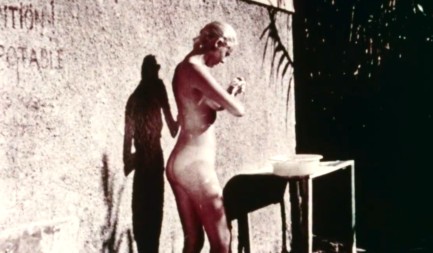 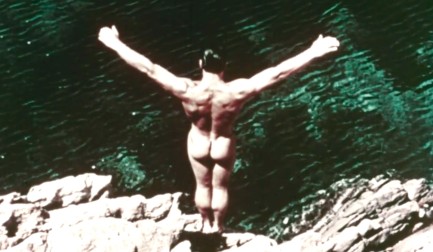 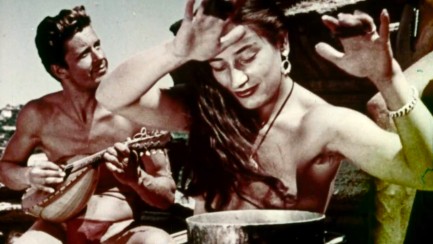 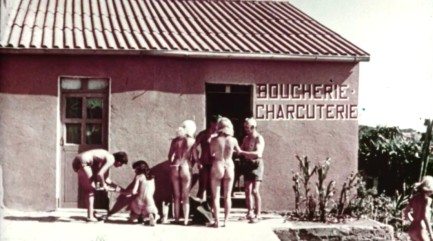 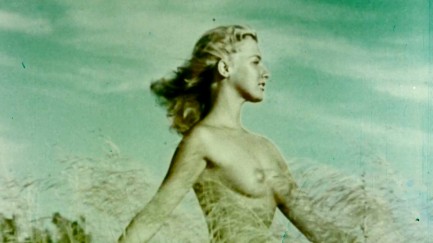 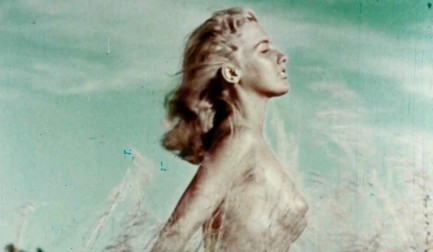
 The more things change the more they stay the same. 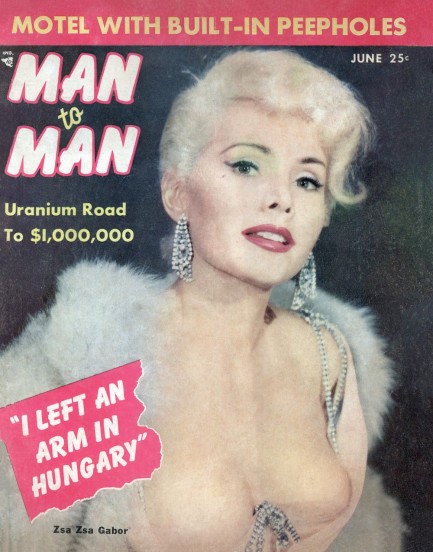
Reading old magazines has helped teach us that things have not changed as much as some people would like you to believe. This issue of Man to Man hit newsstands this month in 1957. We've now seen trans stories in nine mid-century publications, and keep in mind we've not seen even a fraction of a percent of all the magazines ever published. The person under the spotlight this time is Abdel Ibrahim, and Man to Man editors say about him merely that he's “changing from a man into a woman,” and, “he's in an Egyptian hospital for an operation designed to help.”
This dispassionate tone has been the norm, from what we've seen, and shows yet again how the process of creating hysterical prejudice works. First, you train people to believe something unprecedented is occurring, then you frame that as a threat to people's “way of life.” But these old tabs serve as an inconvenient truth—sex reassignments have been around for quite a while, and before then, men who passed or attempted to pass as women go back into the depths of history.
During the mid-century era many trans people became national or international celebrities, from Coccinelle to Christine Jorgensen to Ajita Wilson. The knowledge of transexuals was so mainstream that the top-selling tabloid Whisper even published a 1965 story titled, “A Doctor Answers What Everyone Wants To Know About Sex Change Operations,” with the key word in that header—everyone—suggesting that the dominant reaction socially speaking was neither anger nor fear.
Elsewhere in Man to Man you get Zsa Zsa Gabor, including in one photo that looks familiar, sex myths of 1957, motel peepers, war, crime, fiction, a bit of nudism, and a bit of burlesque. You also get two pieces of art from popular illustrator Mark Schneider, who we've highlighted before. He mainly worked for Sir! magazine. We put together a collection of his covers for that publication which you can see here. You can also see three more issues of Man to Man by clicking its keywords below and scrolling down.
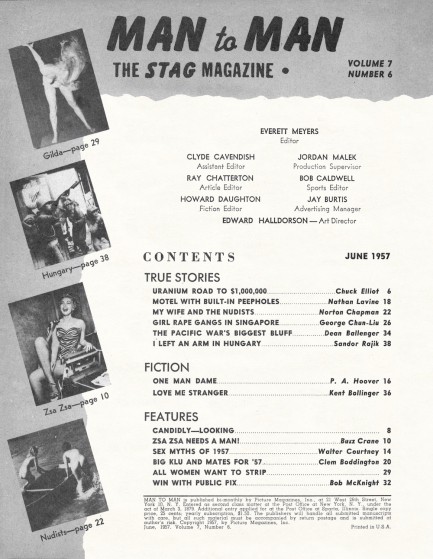 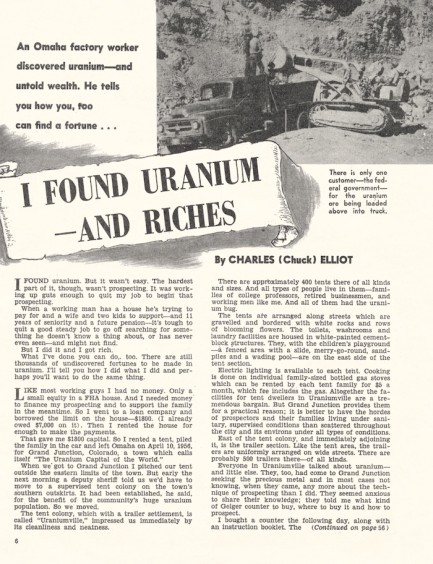 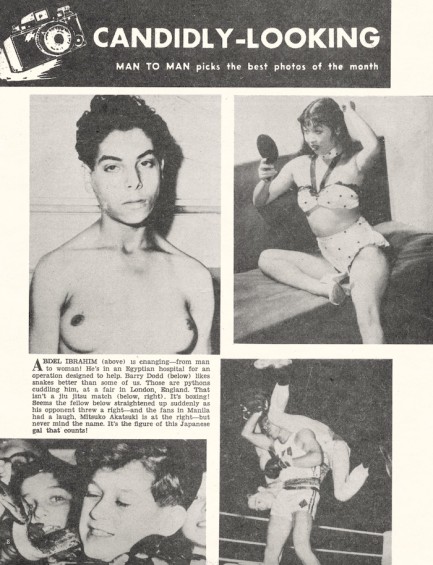 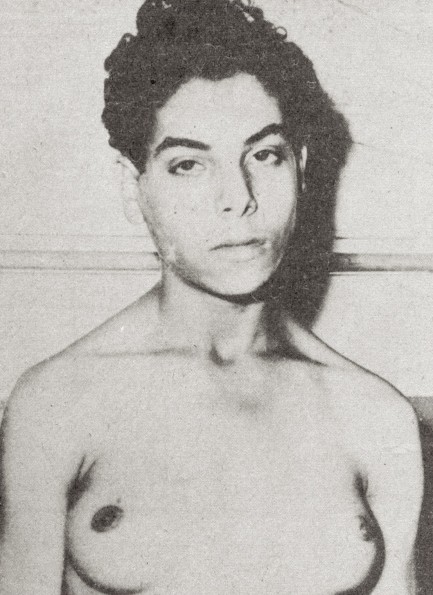 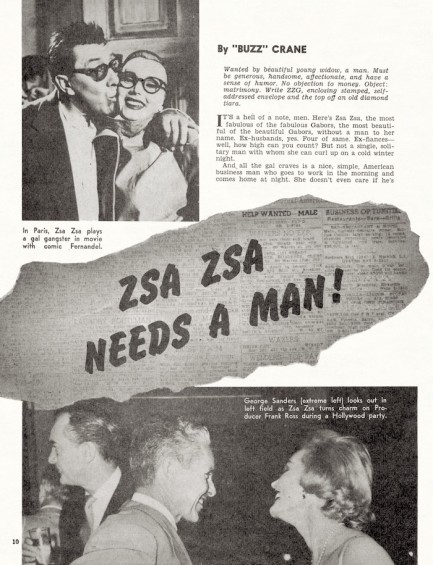 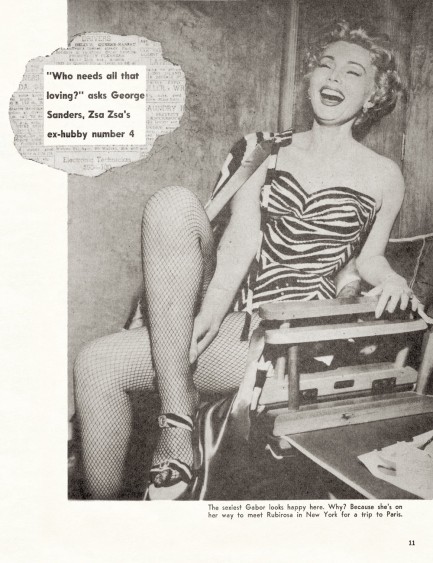 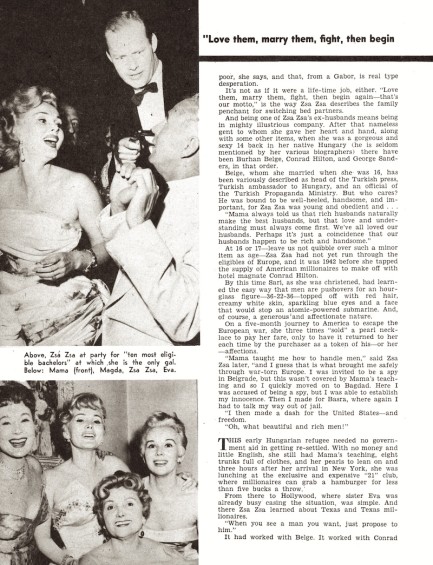 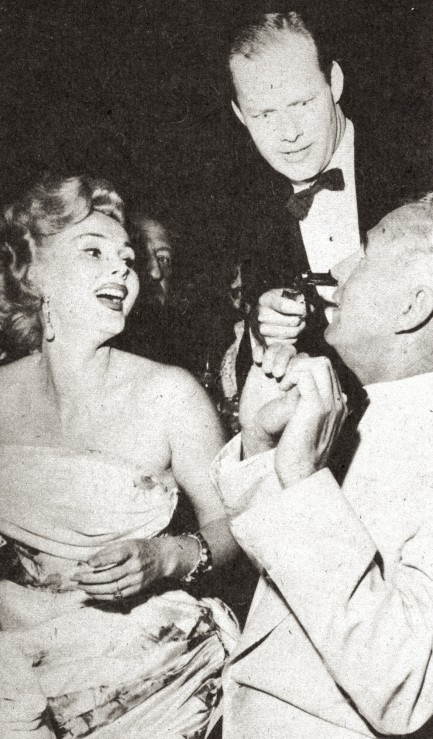 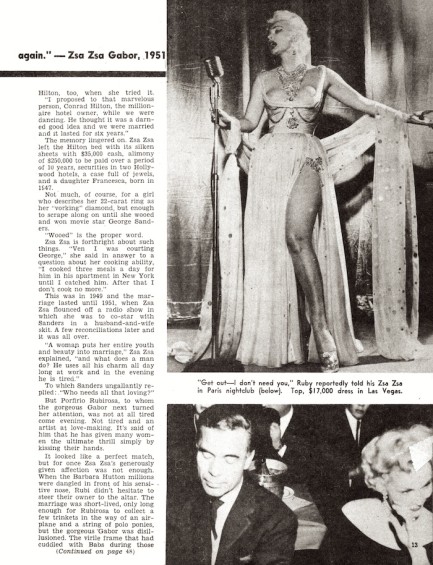 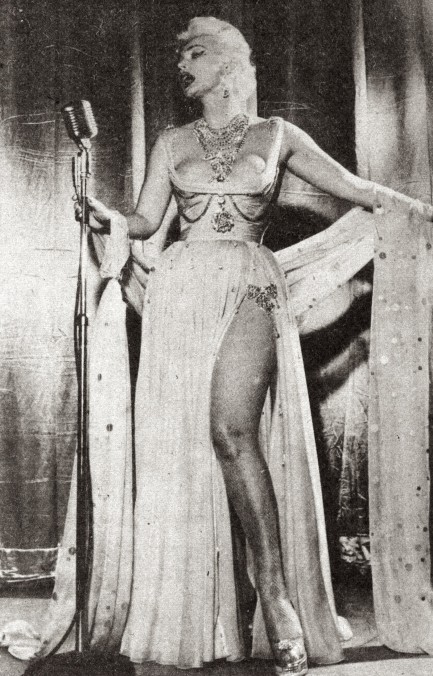  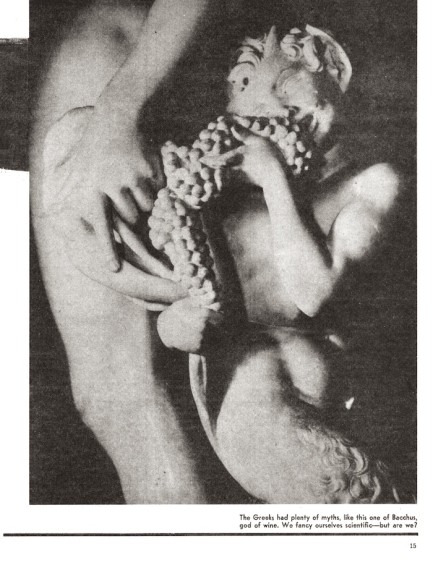 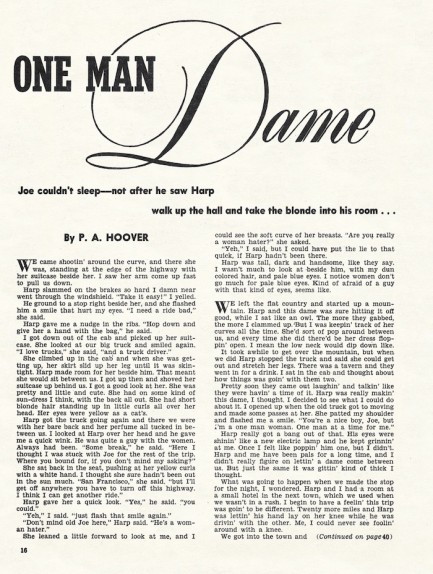 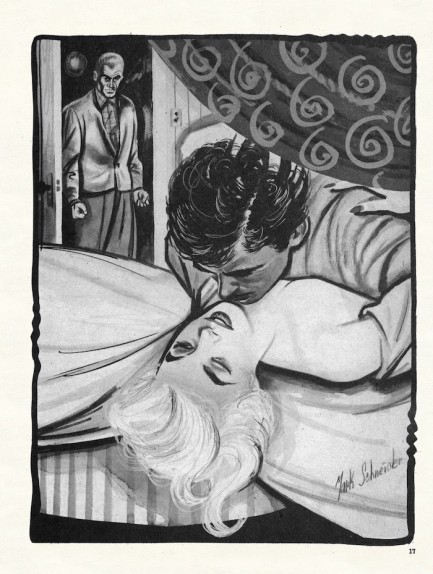 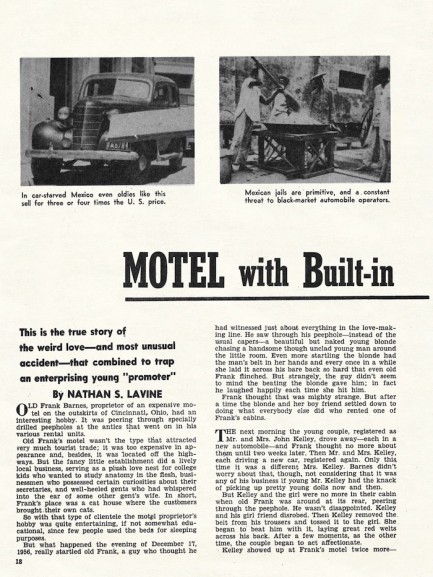  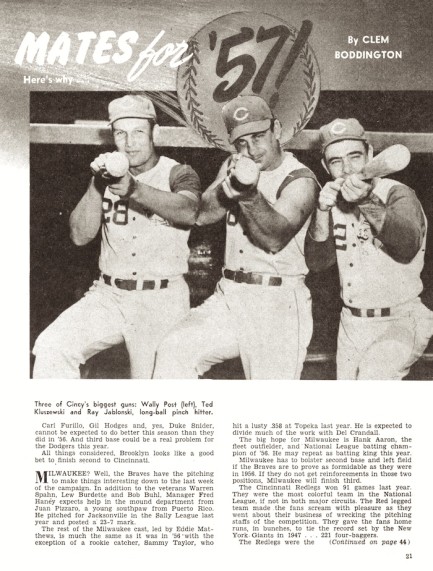 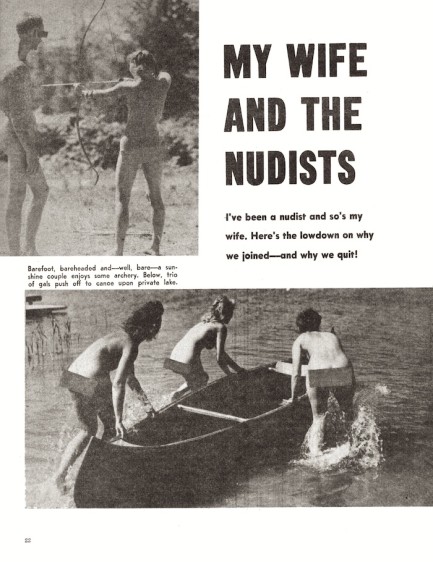  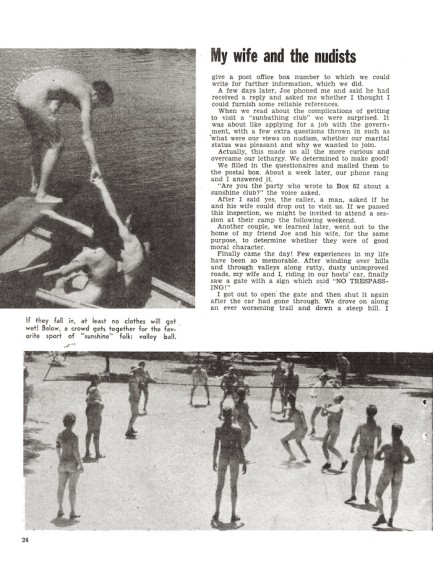 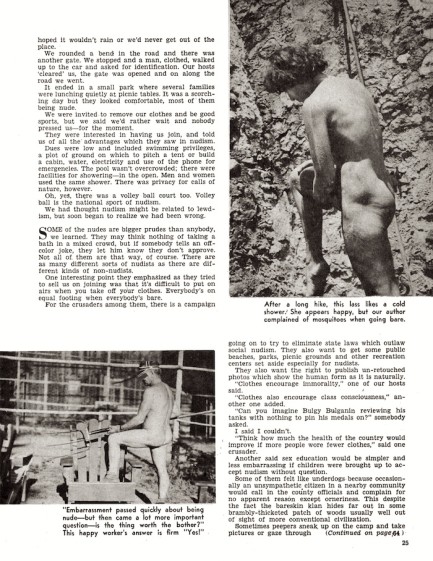 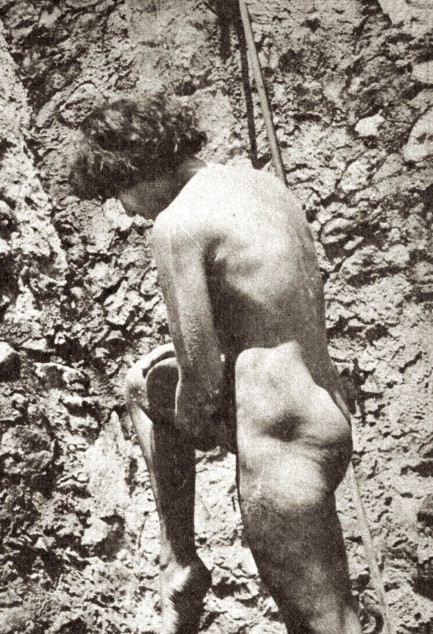 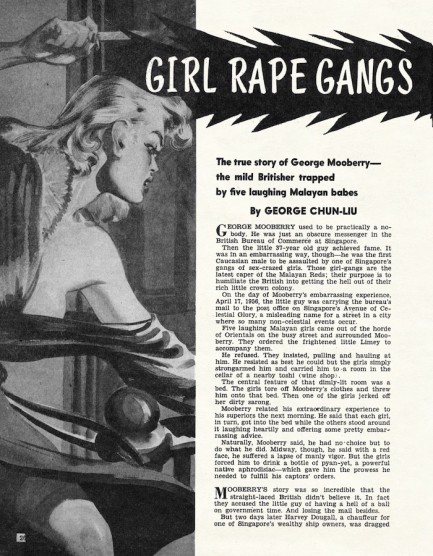 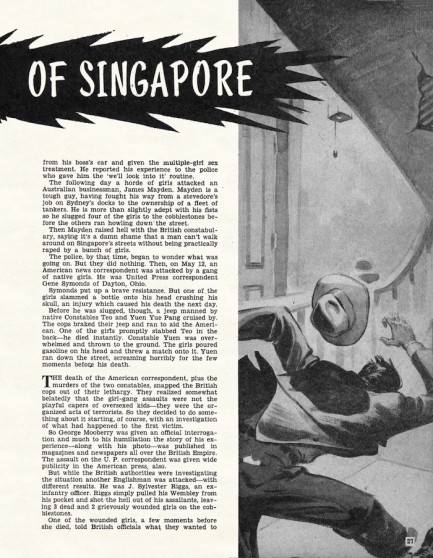 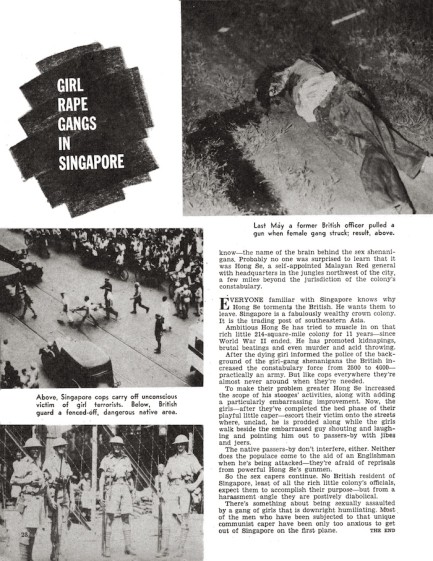 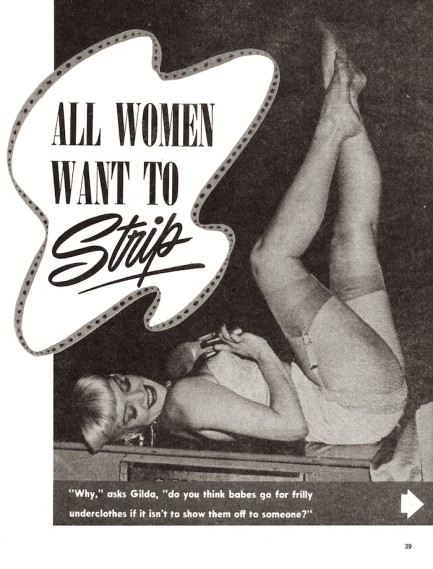 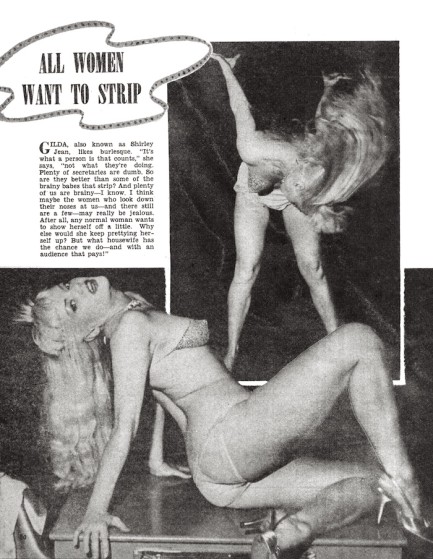 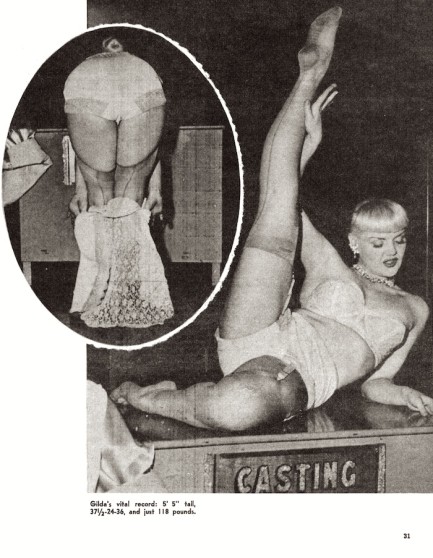 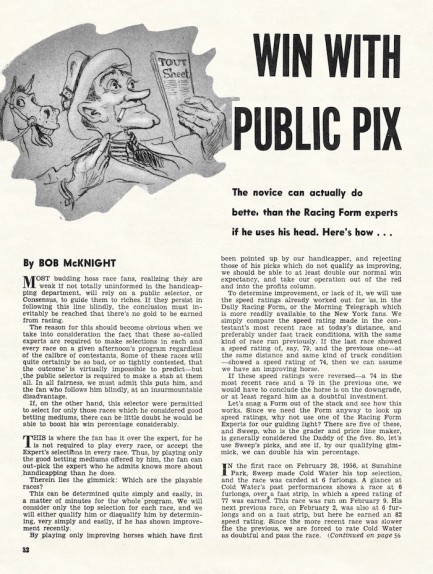 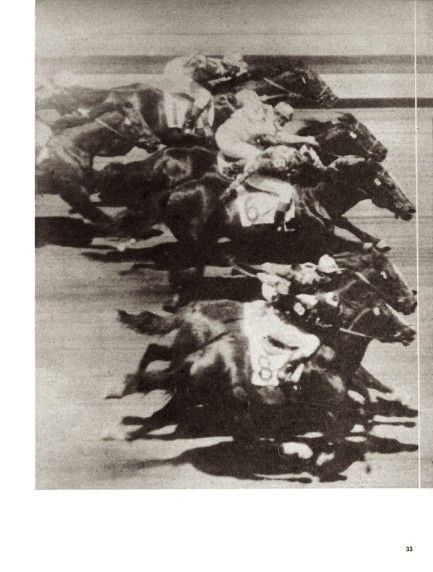 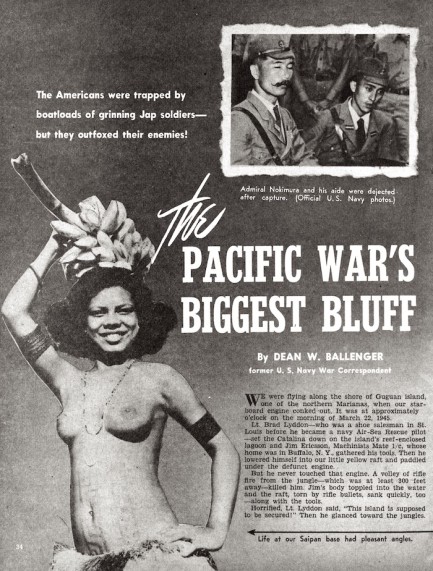 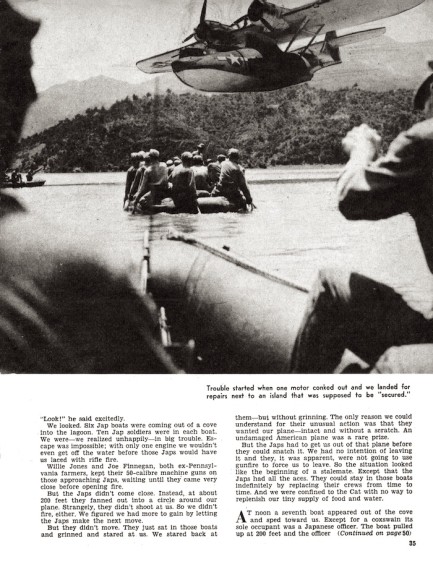 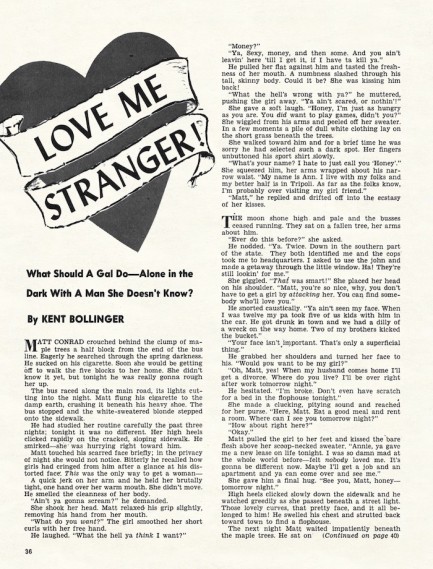 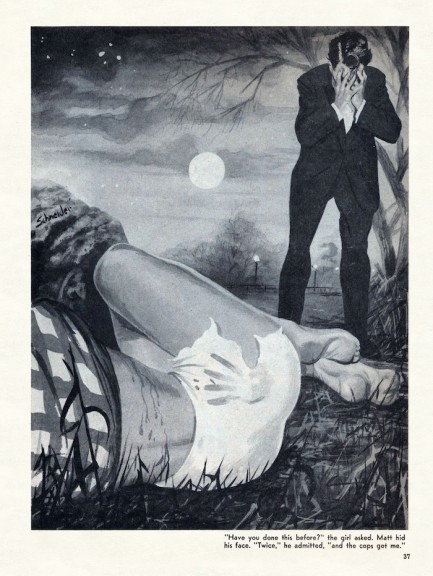 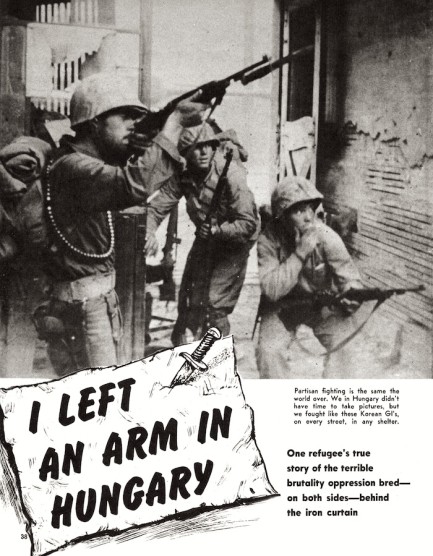
 I've decided to start a nudist colony. What do you think? Any chance of success? 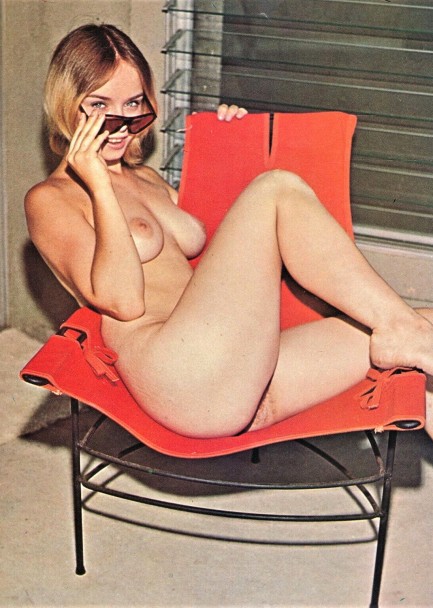
Monica Gayle was a b-movie actress extraordinaire, appearing in more than thirty mostly low budget films, including Switchblade Sisters, The Harem Bunch, The Erotic Adventures of Pinocchio, and, quite memorably, The Stewardesses, in which she's onscreen for only a few minutes but performs the lotus position in a way you've probably never seen. We also just saw her in Southern Comforts, which is why we're featuring her today—we figured after all those fuzzy screenshots we needed to give you a clearer look. Posing nude was no rarity for her. She appeared in probably a dozen men's magazines, often quite explicitly. This more modest shot of her comes from an issue of the nudist publication Sun Buffs and is from 1970.
 Burlesque sensation Blaze Starr takes the obvious next step in nudity related activities. 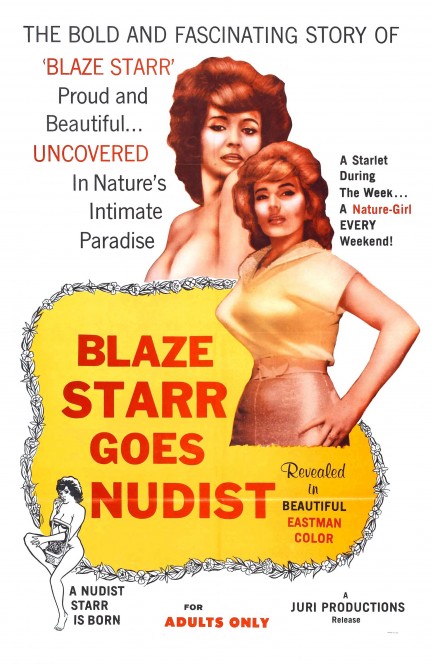
Blaze Starr was one of the most famous burlesque dancers of the mid-century era thanks to both her on- and off-stage activities. She began headlining in clubs during the early 1950s, soon earned the sobriquet “The Hottest Blaze in Burlesque,” and later became not just famous, but infamous, due to having embarked on a tempestuous affair with Louisiana’s impulsive governor Earl Long, who she was still seeing when he died of a heart attack in 1960. Above is a promo poster for Blaze Starr Goes Nudist, which premiered today in 1962, well after Starr had become a household name.
In the film, Blaze, who plays a mainstream actress rather than a stripper, decides she needs a break from her demanding career and busy public life. She decides to spend weekends at the Sunny Palms Lodge in Homestead, Florida in order to enjoy a little nude rest and recreation under the phony name Belle Fleming. Her sinister looking agent/fiancée is apoplectic about this, but he'd be really annoyed if he knew Starr and the camp administrator were making googly eyes at each other. Aside from flirting, Starr indulges in the usual nudist colony activities—sunbathing, archery, dozing in a hammock, tiptoeing around the communal pool, taking romantic walks in the mosquito infested woods, and listening to some schlub play an accordion.
Forget anything resembling acting ability here—everyone is atrocious, and Starr is worst of all. The blame may not be entirely hers, though. The movie was obviously made fast and cheap, and it was directed by Doris Wishman, who helmed such epics as Nude on the Moon and Bad Girls Go to Hell, and is considered by some to be one of the worst practitioners of her craft ever. But we all know the movie is simply meant to be eye candy. On that score it works. Considering the unflattering range of bodies possessed by normal humans, it's clear that most of the female nudists involved in this production are models, and probably some of the males too. Starr looks pretty good herself, even with her wonky boobs and ridiculous helmet of flaming red hair.
The movie is meant not only to display Starr, but to espouse and promote the nudist lifestyle—and really, considering that there's a little plug for Sunny Palms at the outset, it could actually be considered a long form advertisement for the colony. We bet the membership—so to speak—really expanded—so to speak. We can't say Blaze Starr Goes Nudist is a good movie, but it's totally harmless and infectiously fun. There can never be too much of those things in the world. You can see more of Starr at the bottom of this post, and you can see a fascinating piece of Starr memorabilia here (sent to us by a reader way back before our Reader Pulp uploader bit the dust).
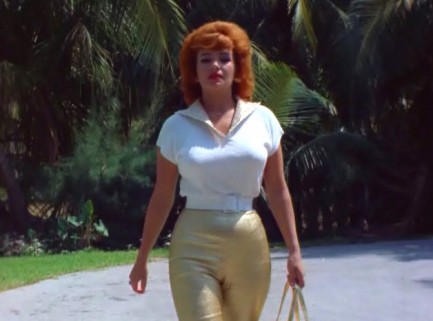     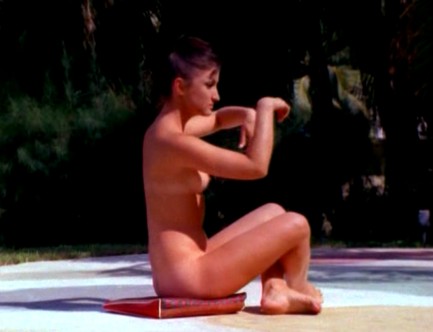 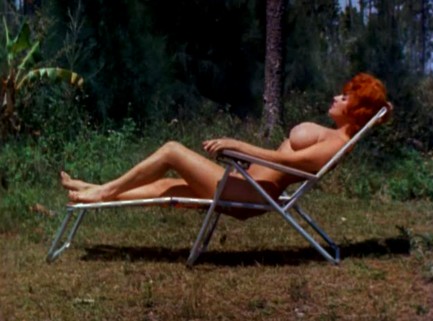 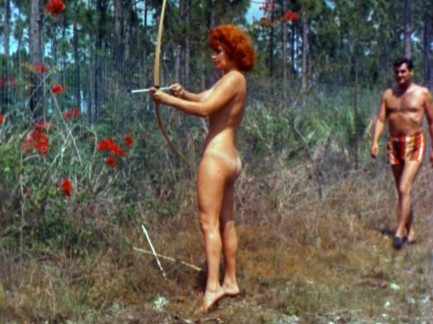
 I agree we should put off getting married. For one thing, we'd both have to get divorces first. 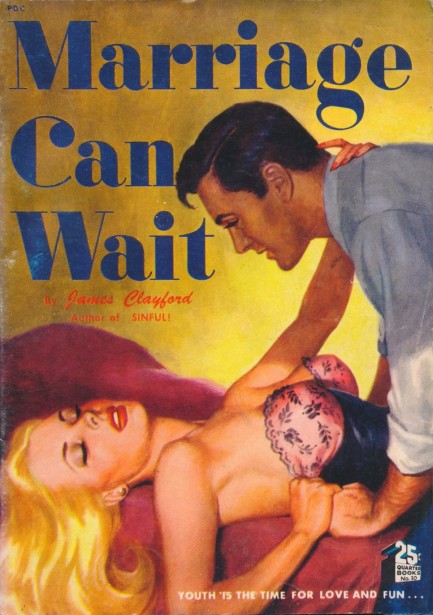
We've said it before—you never what you're going to get when you buy vintage paperback digests. The cover art, as in the case of James Clayford's 1949 novel Marriage Can Wait, often has nothing to do with the content. This looks straightforward but it's one of the stranger tales you'll come across. It was written by Peggy Gaddis under her Clayford pseudonym, and it's about a hard partying yacht trip from New York City to Jacksonville, peopled by six jet-set types and one everyman named Tony Ware. As the only unwealthy person aboard aside from the crew, Tony takes it badly when the yacht's owner Elaine Ellison jilts him one night. She'd invited him to her cabin for nocturnal fun, but he arrived to find another man there. In embarrassment and disgust he jumps overboard and swims ashore. He thinks he's swimming to the Florida mainland. He actually ends up on an island nudist colony. He's horrified, but since supply boats come only once a month the only way he can eat is to doff his garments and join the colony. And it's there that he finds true love in the form of Eve Darby.
Tony's yachting pals, who are habitually hungover each day, assumed he'd abandoned them in port one morning and they'd simply slept through it. Nobody is concerned except Elaine, who realizes she behaved terribly toward him. Weeks later they sail to the nudist island thanks to a bizarre subplot that has them half-jokingly searching for Blackbeard's buried treasure. They don't know the place is inhabited, but they soon find out, and can only stay if they agree to become nudists, which Elaine and her five idle rich friends do in order to secretly search for the treasure. They of course find the long lost Tony, and Elaine is ashamed at how she treated him, then smitten as she realizes she loves this newly bronzed hunk. The only way to try and win him over is to stay at the colony—plus the treasure might be there too—so she settles in for an extended nude sojourn. We'll stop the synopsis there except to say that you have to give Gaddis major points for creativity. The cover art, by the way, is uncredited.
 I knew we'd have to fight to get a train at rush hour. We should have taken the three-fifteen. 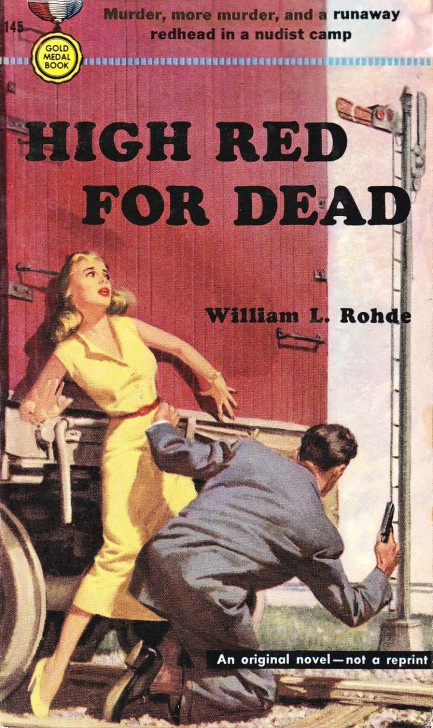
Above: an uncredited cover for High Red for Dead, 1951, from William L. Rohde for Gold Medal. An author chooses yet another interesting profession for his protagonist. This time he's a railroad detective named Mo Daniels who sets out to solve what looks like a deliberate train derailment. Could the disaster have been caused by a competing railroad, the airlines, board members betting on the business to fail? None of the above? Rodhe unexpectedly takes the mystery to a nudist colony where there's a bizarre mile-long footchase through the wilderness between Daniels and a femme fatale named Lucretia Polestra, but otherwise the tale sticks to familiar caper territory. Mo is no schmo—he's as tough as they come. We liked High Red for Dead because of the railway backdrop and nudie sidebar, but we wouldn't call it top notch. If you find it cheap, go for it.
 *sigh* This was more fun before the social distancing thing. 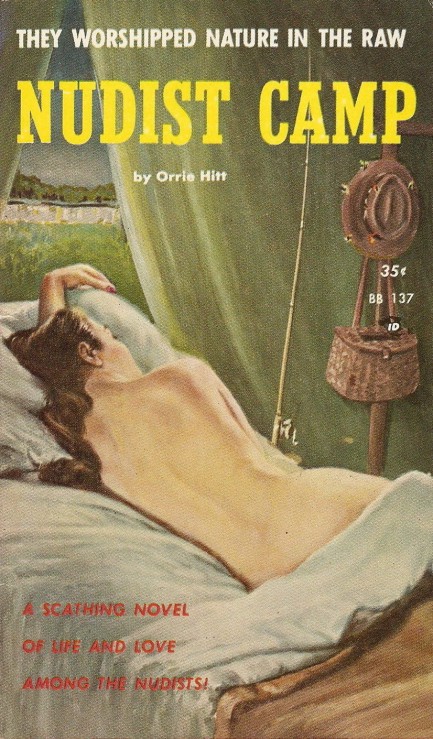
Orrie Hitt turns his sleazolicious talents to the subject of nudism for the succinctly titled Nudist Camp, published by Beacon Signal in 1957. We're treated to the story of an Icelandic immigrant to the U.S. named Della who finds herself needing to earn her keep due to a looming divorce, and turns her patch of rural land into a nudist resort. Problem is her partner in this scheme is secretly planning to photograph the visitors and blackmail them with the prints. When Della finds out, she's aghast, and bends her efforts toward thwarting this rude plan, leading to a scheme to steal the photos and hopefully burn them. Mixed into the intrigue is a bit of romance, and lots of waxing rhapsodic about Iceland and its beautiful women. That part Hitt actually got right. We've been there, and the women do in fact often have perfect ivory skin. Despite these factoids, and the exploration of body-free culture, Nudist Camp is a preposterous tale, uninspiringly told, signifying very little. You know what would have made it a lot better? More nudity. Go and figure. The cover art here is by Bernard Safran, and was adapted from a piece that originally appeared on the front of 1953's Male Virgin.
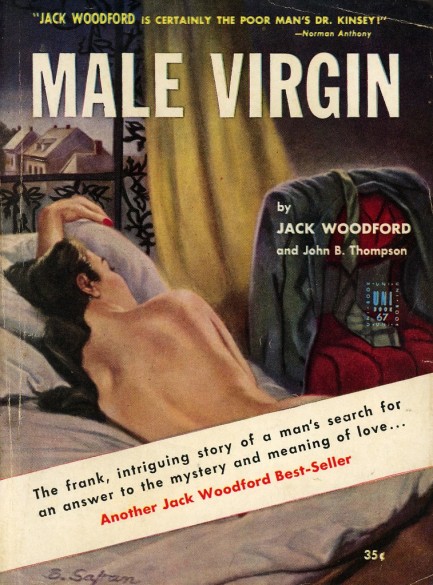
 Pop culture magazine offers a look at post-Franco Spain. 
Ages ago we found a stash of Spanish language magazines and books in a neglected closet in a stairwell in our apartment building. They were caked with dust, so we knew they'd been left to rot. We helped ourselves to a few, but didn't scan much of the collection because it was more contemporary than our usual offerings, and because the magazines were in large formats that needed piecing together in Photoshop. But we had a little time today (plus the Pulp Intl. girlfriends want us to clear out some material) so we have some scans from the Spanish magazine Interviu. This issue hit newsstands today in 1977 and features cover star María Carlos, model Virna Lisa, and Swiss icon Ursula Andress, who's the entire reason we did the scans. There's also a feature on nudism in Spain.
On the whole Interviu is a pop culture magazine, but with the crucial difference that it was published in a Spain recently freed from decades of dictatorship. Therefore the focus on politics and conflict is pretty heavy. We found four of these and all them play the dirty trick of placing photos of nude models on the overleaf of pages showing corpses. You're looking at a beautiful woman, then flip the page to see a dude with his skull smashed open. One issue had a photo of a guy torn to shreds by a bomb. We mean no recognizable body at all, just shoes, mangled flesh, and a few bones. In color. If the idea was to force readers to see the consequences of war, mission accomplished. But don't worry—we didn't include any of those scans, so scroll with confidence.
 National Spotlite goes where few tabloids dare to follow. 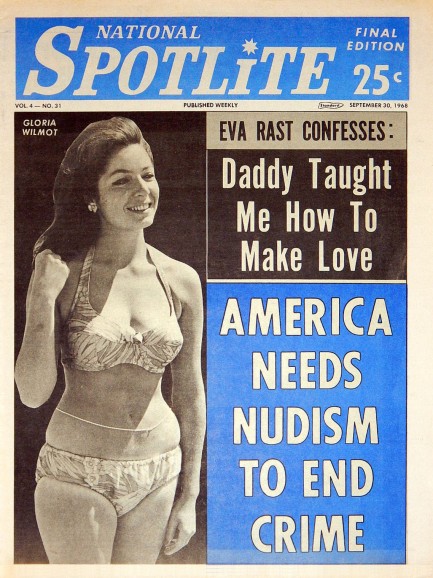
How far did cheapie tabloids go in their quest for continually more outrageous stories? Pretty damn far, as this issue of National Spotlite published today in 1968 shows. The editors give the cover to Gloria Wilmot, but it's Eva Rast who brings the shocks by claiming that her father—in hands-on fashion—taught her about sex when she was thirteen. You know how this works by now. Eva Rast is supposedly one of “the top actresses in Europe,” but has no presence anywhere on the internet. Spotlite claims she starred in The Lotus Flower with Cliff Richard, but while that title is shared by several movies made in different eras, no film called Lotus Flower was made during the mid- to late-1960s, it doesn't appear on Cliff Richard's IMDB page, nor does the page list him as acting in anything between 1968 and 1973.
So what we have is a pretty detailed piece of fiction produced back when there was no handy internet to vet the claims proffered as facts. What does “Eva Rast” say about the event? About what you'd expect: “Mother was out. I asked dad where she had gone and he told me she went to my grandmother's for a week. He said, 'We're on our own and we'll have to make do.' I was real happy about it because it seemed like an adventure that daddy and I were sharing.” And so forth. In the mid-century tabloid lowering-the-bar sweepstakes National Spotlite has taken pole position. Can it be outdone? We have about forty tabs left to look through, so we wouldn't be surprised. We'll report back. See more Spotlite here, and more tabloids at our index here.
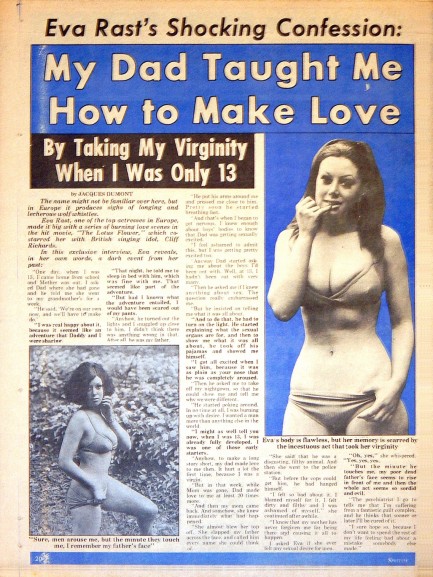

|
 |

The headlines that mattered yesteryear.
2003—Hope Dies
Film legend Bob Hope dies of pneumonia two months after celebrating his 100th birthday. 1945—Churchill Given the Sack
In spite of admiring Winston Churchill as a great wartime leader, Britons elect
Clement Attlee the nation's new prime minister in a sweeping victory for the Labour Party over the Conservatives. 1952—Evita Peron Dies
Eva Duarte de Peron, aka Evita, wife of the president of the Argentine Republic, dies from cancer at age 33. Evita had brought the working classes into a position of political power never witnessed before, but was hated by the nation's powerful military class. She is lain to rest in Milan, Italy in a secret grave under a nun's name, but is eventually returned to Argentina for reburial beside her husband in 1974. 1943—Mussolini Calls It Quits
Italian dictator Benito Mussolini steps down as head of the armed forces and the government. It soon becomes clear that Il Duce did not relinquish power voluntarily, but was forced to resign after former Fascist colleagues turned against him. He is later installed by Germany as leader of the Italian Social Republic in the north of the country, but is killed by partisans in 1945.
|

|
|

It's easy. We have an uploader that makes it a snap. Use it to submit your art, text, header, and subhead. Your post can be funny, serious, or anything in between, as long as it's vintage pulp. You'll get a byline and experience the fleeting pride of free authorship. We'll edit your post for typos, but the rest is up to you. Click here to give us your best shot.

|
|






















































































